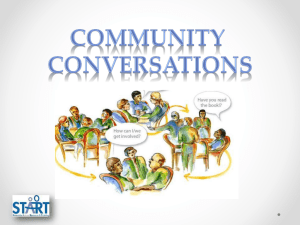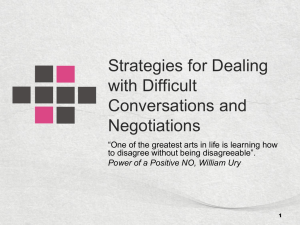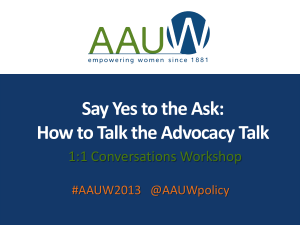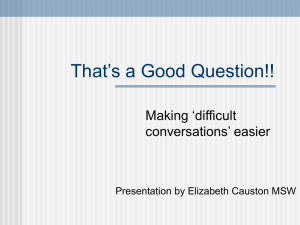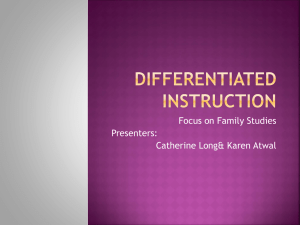Purposeful Leadership
advertisement
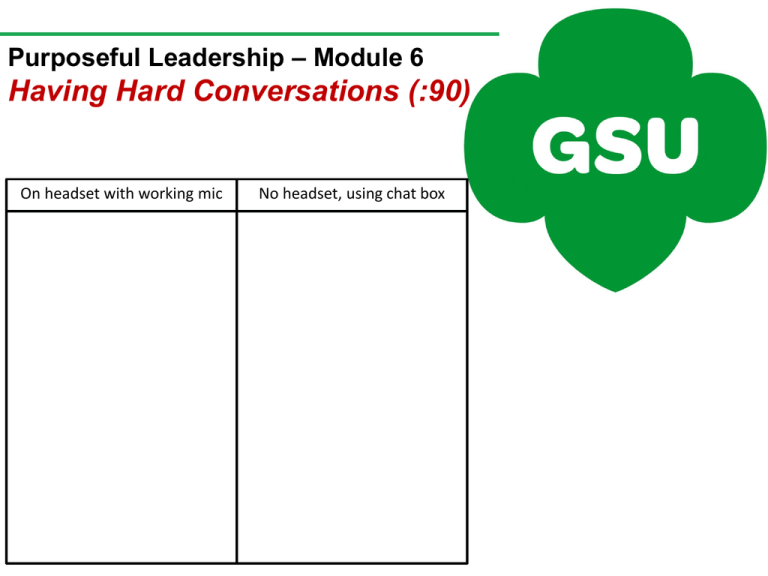
Purposeful Leadership – Module 6 Having Hard Conversations (:90) On headset with working mic No headset, using chat box Purposeful Leadership Leadership and Personal Accountability Emotional Intelligence Balancing structure and freedom Leading Change Coaching Opportunities Hard Conversations They build on each other, AND they stand alone 2 Learning Objectives • Identify a process and principles to follow when having hard conversations • Identify the tradeoffs for different approaches to resolving conflict. • Practice having a hard conversation that you feel needs to occur with a friend/colleague/family member, etc. • Explain what it means for leaders to “confront people with their freedom” Agenda • Who’s here and where are we going? (:10) • Working thru Conflict (:10) • Hard Conversations reasons, principles (:10) • Hard Conversation Demo (:10) • Hard Conversations practice (:15) • Leadership, HC and Conflict in action (:30) • Summary (:05) 4 5 Writing on whiteboard in breakout rooms Breakout Discussion 1. In your breakout group, ….. 2. Read the quote and ….. 3. Summarize your thoughts using ….. Once you are in your breakout room and the instructions slide is pushed out, you will see a menu like above where you can navigate to a blank page and enter group discussion Notes. Use this same menu to go back and forth between the instructions slide and your “notes” page. 6 1. In your breakout group, ….. 2. Read the quote and ….. 3. Summarize your thoughts using ….. Click on the drop down menu then pick the blank page you want to go to jot down thoughts/notes. 7 other 8 Conflict Resolution Options H “Compete” W/L 1+1 = 1 Courage “Compromise” Wsome/Lsome 1+1 = 1.5 (your needs) L “Collaborate” W/W 1+1 = 5 “Avoid” L/L 1+1 = 0 “Accomodate” L/W 1+1 = 1 H Consideration (their needs) 9 Based on my own experience, my primary approach to resolving conflicts is… A. Competing B. Avoiding C. Compromising D. Accommodating E. Collaborating Thomas-Kilmann Conflict Mode Instrument 10 Resolving Conflicts Productively - Overview 4 Explain your goal and problem solve. 1 Manage yourself first. Am I ready to have this discussion? 2 Move to neutral place. Why don’t we…? 3 Hear their side. Let me make sure I understand what you want… Did I get that right? What I’m trying to do here is…. I think we can find something that works. Let’s see what we can come up with… 11 Three Good Reasons… • To address an incident or troubling pattern • To understand their story • To express your feelings 12 Hard Conversation Scenarios • • • • • • • • • • • • • Talking to a team member who isn’t keeping commitments Talking to a coworker who behaves offensively or makes suggestive comments Giving the boss feedback about his/her behavior Approaching a boss who is breaking her own safety/quality standards Critiquing a colleagues work Confronting a colleague who is withholding information/resources Giving an unfavorable performance review Ending a relationship Asking in-laws to quit interfering Asking a friend to repay a loan Asking a roommate to move out Resolving custody or visitation issues with a spouse Dealing with a rebellious teen From Crucial Conversations: Tools For talking When Stakes Are High 13 When Giving Tough Feedback… • Check your intent (if it is to “get even” or take someone down a notch, don’t do it) • Be specific (“you didn’t do a very good job” or even the positive “you did a great job!” is not very helpful) • Describe vs. label (“I was getting frustrated when you interrupted Maria for the 3rd time in our meeting this morning”… is better than “Why were you so rude to Maria today?”) 14 When Receiving Tough Feedback… • Make sure you are ready • Summarize to confirm your understanding (you don’t have to agree, but you should at least make sure you understand how the other person perceives things) • Treat it like a gift (say “thanks” if their intention was to help and remember you get to decide what to do with the gift) 15 Hard Conversations – Process • Find a neutral location to have the conversation 1. Ask to collaborate 2. State your observations “This is the pattern I’m starting to see..” 3. Explain why it concerns you (impact on you, the team and/or organization) 4. Ask if your “story” is legit (“Is that fair?”) 5. Wait for their response No Ready to own? Move to problem-solving Yes 16 Hard Conversations – Practice 1. Decide who will be feedback “Giver” 2. Giver provides Receiver with some background/context (“so here’s the situation…”) 3. Once receiver feels they have an understanding of “who they are”/the status of the relationship, Giver starts 4. Receiver responds based on how well Giver does 5. After some discussion, discuss how it went and what you noticed 6. Take :10 or so * Don’t talk about the situation – Have the conversation * 17 “I have never been a memo guy. I like to speak to people in person. But face-to-face communication is not something that is practiced regularly in most organizations. As a matter of fact, it is often avoided – especially in business. Many managers don’t like to deal with confrontation – which, unfortunately, has the same negative connotation as ‘discipline’ or ‘work.’ People are not truthful and open with each other simply because the truth is often the most difficult pill to swallow for the person receiving it. It is also difficult for the person delivering it. I believe, however, that confrontation is good.” ~ Mike Krzyzewski, Leading with the Heart 18 Saving Private Ryan • Special “project” • Lost one man to sniper • Stumble upon a machine gun bunker = decision • Lose their medic • Project team seriously questioning “why” 19 Breakout Discussion Assume you are Tom Hanks, the team is disintegrating in front of your eyes: • Ryven wants to bail on the mission • The Sergeant is getting ready to shoot him for desertion • The rest of the team is seriously questioning their own commitment and the sergeant's old school approach What do you do? Take (:08) 20 Suggestions… 1) A simple way to de-escalate a conflict situation is to move yourself and the person you’re talking with to a different setting, and use collaborative language in the beginning. “Help me find a solution that works for both of us.” 2) When offering your thoughts about the team’s or other’s motivations, speak only for yourself. “I can’t speak for the rest of the team, but for me, I think…” 21 Closing Thought… “It helps to think of freedom as being the choice to be the creators of our own experience and accept the unbearable responsibility that goes with that. Out of this insight grows the idea that perhaps the real task of leadership is to confront people with their freedom. This may be the ultimate act of love that is called from those who hold power over others.” ~Peter Block, The Answer To How is Yes! 22 Questions? Comments? 23
